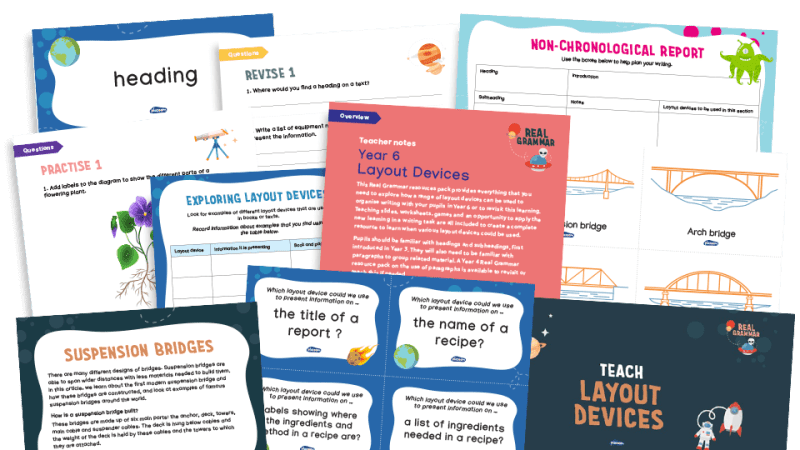Speaking and listening topics – Best resources for GCSE English

Get ready to debate, persuade, agree, disagree and of course empathise with these excellent ideas for the speaking and listening exam…

- by Teachwire
- Classroom expertise and free resources for teachers
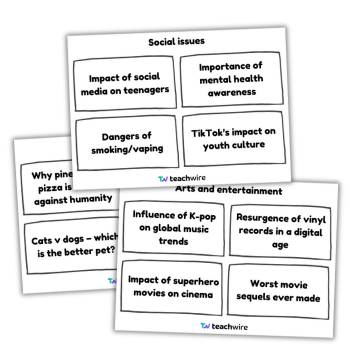
Are your students preparing to choose their speaking and listening topics for GCSE English? Use these resources, lesson plans and activities to help them get the mark they deserve…
80 speaking and listening topics
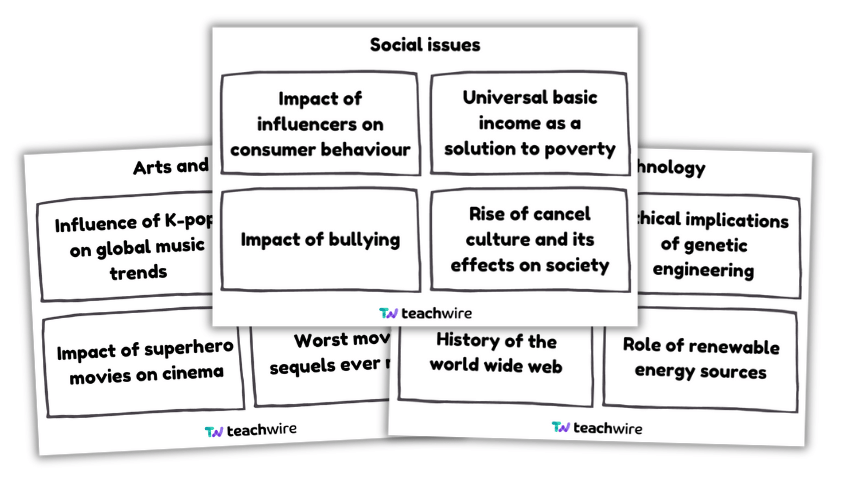
This free English speaking and listening download contains a PowerPoint with 80 topic ideas to inspire your students. There’s also a PDF version too for easy printing.
Subject areas covered include social issues, environmental issues, health and wellbeing, education, science and technology, entertainment, humour and more.
This down-to-earth video from a fellow student is a great one to show in class. It covers choosing your topic, practising your speech, answering questions and more.
Speaking and listening resources
Craft a persuasive speech
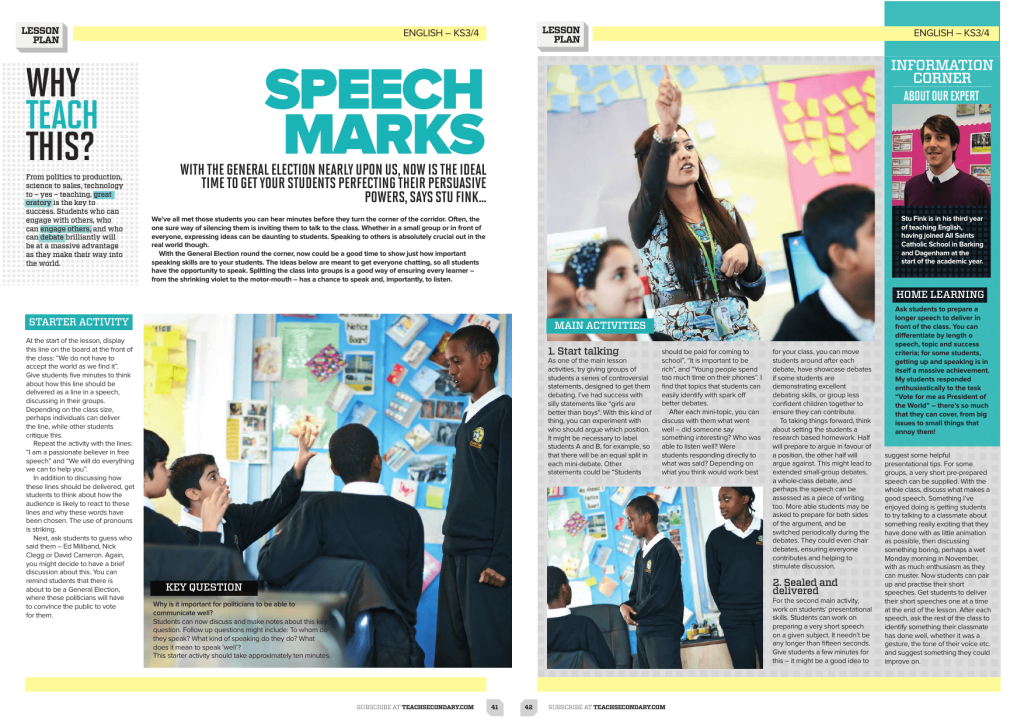
In this free lesson plan from English teacher Stu Fink, all students will get the opportunity to speak (and, more importantly, to listen). You’ll explore why it’s important for politicians to be able to communicate well.
Students will then debate a series of controversial statements in groups. Finally, students will work on preparing super-short speeches (just 15 seconds!) and delivering them effectively. It’s great practice for their own speaking and listening topics later down the line.
Persuasive writing scheme and resources
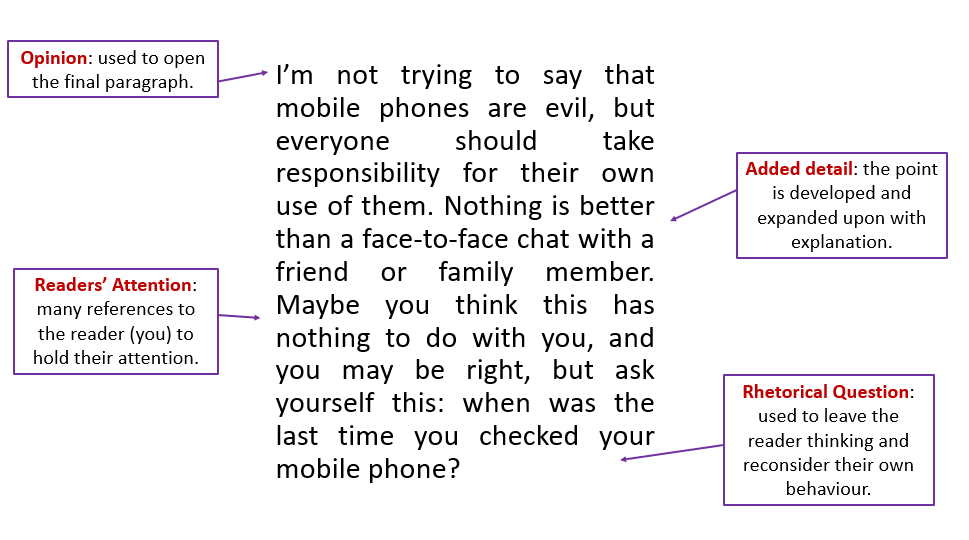
This free persuasive writing unit contains a sequence of lessons all about speech writing. Resources include example speeches that introduce the idea of speech structure and persuasive devices.
There are also examples of good speech introductions, main bodies and conclusions. The assessment task involves writing a speech addressing one of three given speaking and listening topics – Disney and gender inequality; the value of arts subjects; homework.
Speaking and listening topic examples
Watch student Jibreel giving his speech on the topic of free will – which received a distinction.
Here’s another speech awarded a distinction. This time, Charlotte is talking on the theme of why large retailers are killing off the high street and what can be done about it.
Three listening and speaking activities
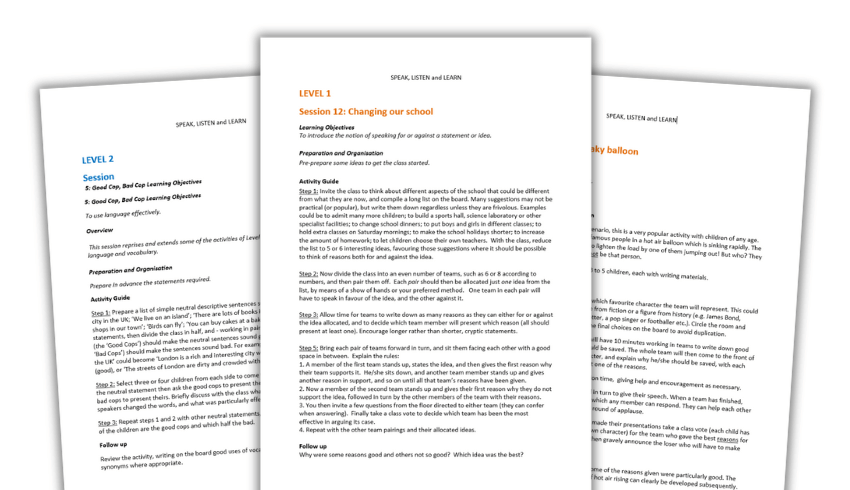
This free download contains instructions for three listening and speaking activities. The activities are:
- Leaky balloon – a thought experiment that helps students to make and respond to simple arguments
- Changing out school – a debate exercise that introduces the idea of speaking for or against an idea
- Good cop, bad cop – working in teams, students prepare presentations about a neutral statement
Activities to turn students into great public speakers

Public speaking doesn’t come naturally to everyone, says Alison Davies – but these fun activities can help students develop the skills they need to succeed…
For those with little or no experience of addressing an audience – like most of our students – it can be a terrifying ordeal with the potential to affect their communication skills well into adulthood.
So how can we make the transition from desk to centre stage an easy one for learners? The key is to make the experience fun. Be creative and give your students the tools they need to speak with confidence and imaginative flair.
Show them not only how to plan what they want to say, but also how to say it in an engaging way – then let them take the floor and shine! Try these ideas…
The Road Show Game
As a starter activity to encourage spontaneity, confidence and creative thought, get your students to sit in a large circle.
Explain that they’re going to discuss the origins of an object that you’ll pass around the circle. Choose an everyday object, like a stapler, paperclip, wallet or doorstop. The onus is on them to use their imagination!
They must pretend that they’re antiques experts and come up with a story about the object’s background and what it’s used for – but this must be something original that hasn’t been said before.
The object can be an artefact from the past, or a future antique. They can be as creative as they like, but they must say something when it comes to their turn.
This activity promotes ‘on the spot’ thinking and active listening, since they have to take note of each other’s opinions. It will also help them express their ideas in a creative and engaging manner.
Go around the circle at least twice. This will encourage everyone to be inventive and boost their confidence, once they realise that they can improvise and come up with new ideas when under pressure.
Telling someone else’s story
Often students are challenged to present ideas and facts which aren’t necessarily their own, thus making the delivery even more of a trial. Help them take ownership of information and improve their general presentation techniques with this fun activity.
Start by asking them to write down the brief outline of a memory. Encourage them to pick something positive, like a fantastic holiday, event or an achievement, or even something amusing that makes them laugh.
In pairs they should swap and read each other’s tales. When they’ve finished, they must take their partner’s memory and make it their own by delivering it as a story ‘from personal experience’ to the rest of the class.
How to do it
To help them prepare, work through the following checklist of tasks
- Ask them to split the tale into easy sections, so that it follows a narrative pattern. Sticking to this structure means that if they go off tangent they can find their way back by picturing the segments of the story in their mind.
- Get them to consider what the story is about, and to make it important to them. Ask them what they feel the core message is. This doesn’t have to be the same as the person who the memory belongs to, as they’ve now taken ownership of it.
- Once they’ve identified the core message and planned what they want to say in a story format, ask them to walk through the tale in their mind and engage all their senses. Encourage them not only to see events unfold, but to consider what they can feel, hear, smell, touch etc.
- Get them to think about the emotions within the story and how to portray these through the tone, pitch and pace of their voice, facial expressions and body language.
- Finally, ask them to think about the story’s core message and how they can reinforce this when presenting the memory.
Finish by sitting in an informal circle and allowing each student to share their memory. At the end, ask the other students to guess what the core message was. In preparing a personal tale, the students will grow in confidence and develop their communication skills.
Know your audience
Before any talk or presentation it’s important to consider your audience. Who are they and what do they expect from you? The most accomplished speaker in the world will fail to connect with their audience if they don’t fulfil their expectations.
Split the students into small groups and give them a piece of information to present in the form of a paragraph about a particular subject or a short newspaper report.
Once they’ve read it, they must identify five key questions that any audience would want to know. This will help them pick out the crucial points they need to deliver and place them in order of importance.
Take this a step further by asking each member of the group to deliver one point. They must organise the presentation as a team and focus on how they’re going to get their particular message across, using the skills they’ve practised previously.
Taking a stand
‘The Old Man, His Son and the Ass‘ is a fable that tells the story of a man and his son taking their ass to market. During the journey they meet different people, each of whom has their own personal view on who should or should not be sitting on the ass.
The man attempts to please everyone to the point of carrying the ass on his shoulders. This ends in disaster, as the ass falls into the river and is never seen again. The moral of the tale being, you can’t please all of the people all of the time.
Tell the story, and then ask the students to pick a character. They must take a stand and deliver that character’s version of events to the rest of the class. This means they have to tell the tale from their perspective, explaining why they said or did what they did.
To help, give your students the following list of tips:
- Believe in what you’re saying
- Picture what you want to deliver
- Engage your emotions and senses wherever possible
- Consider how language sounds
- Use your voice to get the message across
- Plan using the narrative structure
- Enjoy – and remember you are in control
Alison Davies is an author of several fiction and non-fiction books, a professional storyteller and creative practitioner, running workshops at universities throughout the UK and delivering sessions on creative communication and memory building techniques. Visit alisonlrdavies.blogspot.co.uk. Browse more of our oracy resources.
More speaking and listening resources
Are graffiti artists criminals?

Is grafitti art that adds to a culture and a community? If so, who gets to judge that? Where is the line between art and nuisance? Where, if anywhere, might it be acceptable to do it?
Download two PowerPoint presentations to help you explore this idea in class.
Room 101
You’re no doubt familiar with the TV show format, where contestants attempt to persuade the host that their item should be banished for all eternity into Room 101.
Well, it makes for a great speaking and listening activity. If you want to see it in action, here’s a school that filmed their effort and uploaded it to YouTube. There’s also a free PowerPoint lesson plan.
Analysing famous speeches as arguments

This extensive resource spans five 50-minute lessons, covering these areas:
- Analysing a speech for rhetorical devices and their purpose
- Identifying an author’s purposeful manipulation of language
- Identifying elements of argument within a speech
- Writing an analysis of a speech with in-text documentation
Easy ways to introduce oracy in secondary

Instead of screaming in frustration at the ongoing oracy policy vacuum, take some meaningful steps towards improving matters with these ideas from English teacher Jennifer Hampton…
Start by developing a heightened awareness of talk opportunities in your classroom. Who is speaking, and when can you increase those opportunities? Some strategies might include ‘no hands up’ time, think pair share activities and utilising group feedback.
Could your class’ group work activities benefit from guidelines, modelling or sentence openers to facilitate discussion?
You can also think about your curriculum. Could you build up students’ confidence in presenting via the gradual introduction of shorter speaking tasks at KS3? This doesn’t have to be just in English, but across all subjects.
Another step you could take is to analyse the results of your spoken language components for yearly trends. Probe how well your PP-eligible students are faring in this part of the course.
Demand CPD
Demand CPD opportunities and research time, with support from the brilliant organisations and advocates of oracy in the classroom that are among the biggest voices currently clamouring for change, such as Voice 21 and Oracy Cambridge.
Start the conversation with colleagues and senior leaders. Seek to involve students more actively in assemblies, and explore other opportunities for public speaking. Find out what our students think about their oracy development via class surveys, exit slips and questionnaires.
Jenny Hampton (@brightonteacher) is an English teacher, literacy lead and former SLE (literacy).





